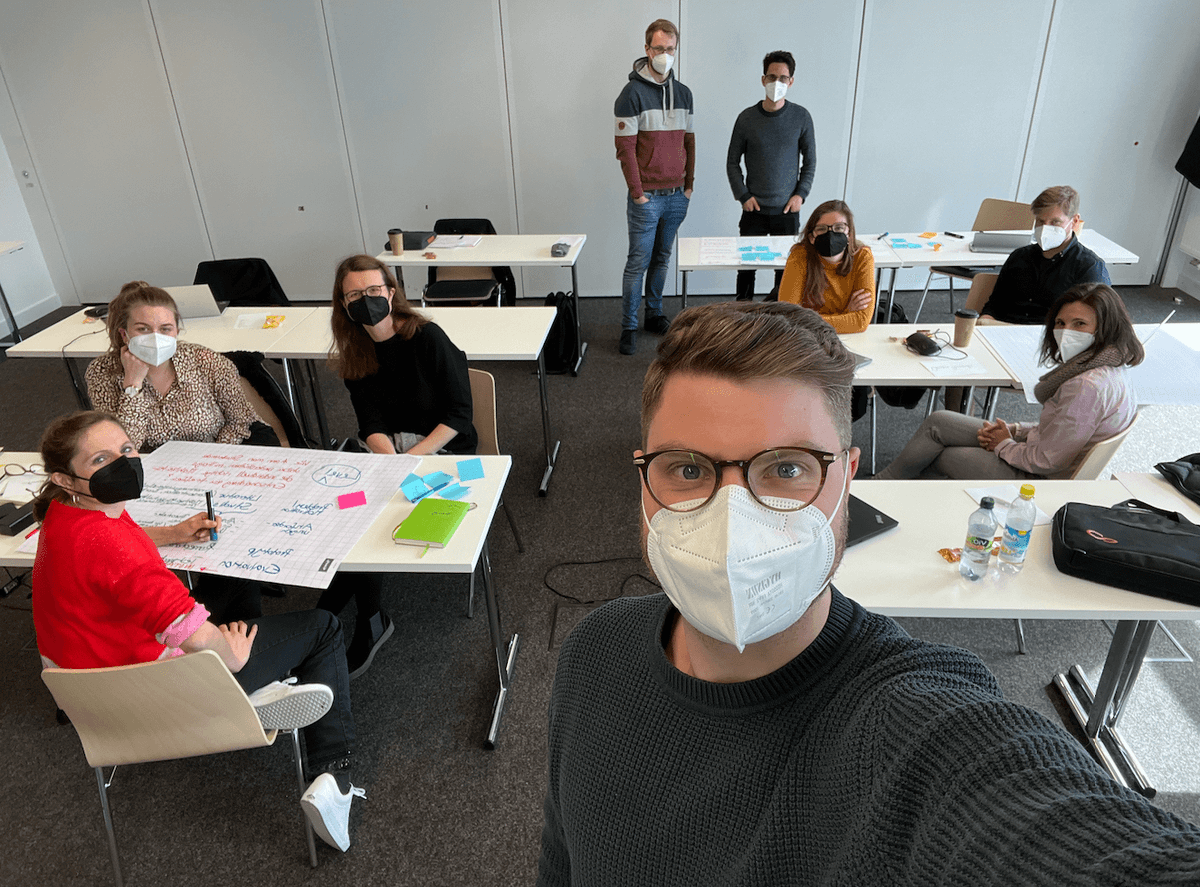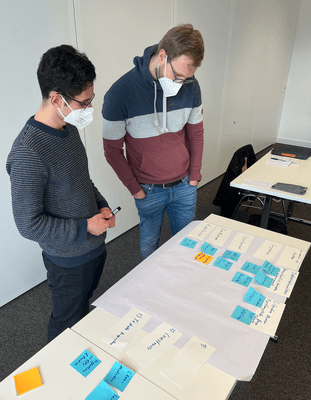Design Science Research Course Iteration No. 2 - Insights, Findings, and Experiences
In the spring of 2022, the doctoral course on Design Science Research took place at the Graduate College of the Technical University of Braunschweig. In this post, we report on our experiences regarding the structure of the course, as well as the discussed contents and findings.

What Moved Me to Offer This Course and Create This Website
This year’s course is the second iteration of the format. The course had already taken place last year at the Graduate College of the Technical University of Braunschweig. In fact, the first run was also the reason for setting up this website.
But what moved me to offer this course in the first place? It’s my enthusiasm for the method of Design Science Research itself, or my own attendance at courses during my doctorate that helped me a lot, coupled with the urge to give something back. But even more, it’s my passion for sharing knowledge with others—I love explaining and teaching and enjoy the exchange with learners!
From attending various doctoral courses at Leibniz University Hannover, Georg-August University Göttingen, and the Technical University of Braunschweig, I was able to gain experience as a participant regarding the structure of doctoral courses. I took away well-proven means and methods, but there were also weaknesses.
The biggest weakness perceived by me was the syllabus with reading assignments and usually the preparation of a presentation prior to the course, which then took place as a block event after appropriate preparation. Only through the on-site mediation and discussion did I feel I understood the topic, and the application to my own research in the presentation prepared beforehand was in need of significant improvement with the newly learned material.
Thus, the following was clear to me:
- The sessions need to be spread out, and there must be time to let what has been learned sink in.
- The kickoff should provide a comprehensive overview and a basic introduction to the relevant topics.
- The classic syllabus in PDF format should be replaced by a website, which offers the possibility to deepen specific topics or explain connections in short videos.
- The course includes various teaching formats: discussion rounds, presentations by doctoral students, group tasks, reading assignments, individual tasks, and presentations on specific topics by the instructors.
At this point, I would also like to thank my colleague Felix, who prepared and conducted the courses together with me.
Goal and Contents of the Course
The goal of the course is to convey knowledge about the theoretical and methodological principles of Design Science Research.
To this end, the fundamental origin of the research paradigm is derived and “design” as such is discussed. In design-oriented research, we change reality through our design—we create things that did not exist before. This understanding, compared to other research approaches, forms the basis.
Subsequently, among others, the following specific topics were addressed:
- What are artifacts?
- Possible approach models for implementation
- Generalizing design knowledge: Transforming insights from instantiations (e.g., a software prototype) into design principles and design theories
- Planning a design cycle and selecting suitable methods and underlying theories (kernel theories)
- The theoretical contents are illustrated with the help of examples from research and successful implementation of Design Science Research
The gained insights were then applied by the doctoral students to their own research projects and discussed together in the group.
Structure and Process of the Course
The course consisted of an online session and two face-to-face days, as well as concrete assignments for individual or group work. The online session, which took place four weeks before the in-person event, served as the first knowledge transfer and introduction to the topic.
In the following four weeks, the participants had time to deepen what they had learned, apply it to their own research, and deal with specific questions and tasks. For example, specific questions on particular topics were answered in group work, and the following contributions were created on this website:
- Question 1: What is an Artifact & Design Knowledge and what forms can it take?
- Question 2: Which DSR approach models are there and what distinguishes them?
- Question 3: What is a Kernel Theory?
- Question 4: What are the three cycles of DSR and what does “rigor” mean?
- Question 5: Which philosophical currents underlie Design Science Research and how are the methods of social research integrated into the design process?
The preparation formed the basis for an interactive exchange on the concluding in-person days: Here, questions were discussed in various formats, research approaches of the participants were presented and discussed, and examples and experiences were shared.
For Example, There Were the Following Three Interactive Sessions:
Session 1: Design Science Research in the Doctoral Project
How do I plan and structure my doctoral project, and what strategic approaches are there?
Session 2: Design Science Research Cycle and Structure of Publications
How do I plan a “design cycle,” and how do I structure a paper in which I communicate my design findings?
Session 3: Best Practices—Generalization of Design Knowledge
What is design knowledge, what forms can it take, and how do I generalize knowledge from instantiated artifacts or transfer generalized knowledge into instantiations?
Emerging questions or challenges were always recorded directly, either discussed immediately or postponed to the concluding FAQ session on Day 2.
Insights into Findings and Results
At this point, I would especially like to highlight the challenges and questions discussed, as they also made me think, and I took a lot from the discussion. A separate blog post could probably be written on each of these questions, so here are just brief prompts. We will take them up as future topics on this site!
- How do I combine my own research project with the project work to be done?
- Align the dissertation topic with the project topic
- Establish and block a fixed research day in the week
- How do I, as a researcher, leave the ivory tower and approach practice?
- Take conversations with the target group seriously, as well as the application and demonstration
- Consider Action Design Research as a possibility
- How do I instantiate artifacts? And what forms can an instantiation take?
- How do I reduce the complexity of design principles?
- Design theories are highly interesting but complex to understand
- Attending courses and exchanging with others promote progress and reveal different perspectives
Here are also some insights into the group work during the course:


Statements from the Doctoral Students
In a feedback round, we recorded thoughts on the course, once with the “I like I wish” method on Day 1 and once with the 5-finger feedback on Day 2. You can see the results in the following photos. Bijan and Jannes were also kind enough to write a few words about the course, which follow below.

Bijan Khosrawi-Rad
Research Topic: Intelligent and game-based design of digital learning applications
“The DSR course by Felix & Timo was a great opportunity to engage in exchange about one’s own research, take valuable impulses with you, and receive feedback on the doctoral project. Particularly great were the in-person exchange, the inspiration gained through insights into the research approaches of other doctoral students, and the creative atmosphere in the course. I especially liked the combination of theoretical input on DSR with applying the new knowledge to one’s own research area. The seminar topics were diverse. In addition to an all-around overview of various approach models and artifacts in DSR, there were also valuable tips on publishing and writing the dissertation.”
Jannes Menck
“The DSR course helped me delve deeper into the methodology and evaluate its suitability for my own research topics. Besides pure knowledge about DSR and its application, I was given the opportunity to present and generate my own ideas in a constructive environment. In particular, the cross-university, interdisciplinary exchange led to very enriching conversations in the plenary and on the sidelines. The course was rounded off with a successful joint meal.”
Conclusion and Outlook
I really enjoyed the second iteration of the course. I learned a lot from the first run and was able to further develop the format. I am very pleased that, thanks to the website, we also had registrations from other universities and participants from very different disciplines—so we had a cross-university and interdisciplinary exchange, which enriched the discussions.
My personal highlight was conducting it in person, which showed me how important real contact is for rich interaction. This cannot be transferred online in the same complexity. The combination rounds off the overall format in the end:
- Kickoff in an online event with an overall overview
- Individual and group tasks both at home and on-site
- Accompanying website
- Sessions, discussion, and presentations in person
And last but not least, of course, the informal exchange over a beer in the evening ;)